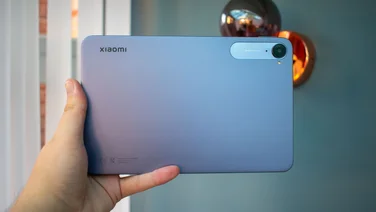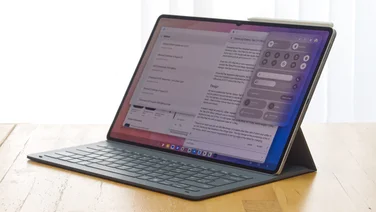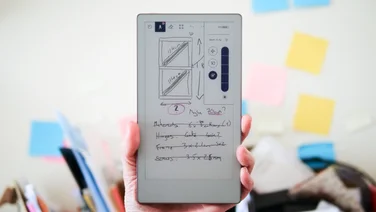To help us provide you with free impartial advice, we may earn a commission if you buy through links on our site. Learn more
- Apple iPad (2018) review: What you need to know
- Apple iPad (2018) review: Price and competition
- Apple iPad (2018) review: Apple pencil support
- Apple iPad (2018) review: Design and features
- Apple iPad (2018) review: Performance
- Apple iPad (2018) review: New core apps
- Apple iPad (2018) review: Verdict
















- Apple Pencil support
- Cheap (for an iPad)
- Has a decent turn of speed
- No keyboard connector
Apple’s keynote presentation last month might not have felt like a major event but its newest iPad is a significant release for the company, not least because it’s the first low-cost (£319) iPad aimed squarely at students.
The slow increase in prices for Apple’s MacBook and iPad Pro devices in recent years means the company has somewhat fallen behind Microsoft and Google in the education space, but this new iPad represents a direct attempt from Apple to regain lost ground.
It’s a welcome development, but some might say knocking off a mere £20 isn’t that big a step forward.
READ NEXT: The best tablets you can buy today
Apple iPad (2018) review: What you need to know
The new iPad isn’t much different from its predecessor in terms of its hardware. It’s the exact same size and weight as the 2017 model and has the same 8-megapixel and 1.2-megapixel rear and front cameras. Storage options are also identical: you can pick between 32GB and 128GB variants.
Inside, the main change is that everything’s powered by a faster A10 Fusion processor. The other significant improvement, which is directly linked with Apple’s push into the educational space, is that it supports the Apple Pencil. Unfortunately, though, there’s no Smart Connector contact for the addition of a keyboard.
Apple iPad (2018) review: Price and competition
At £319 (for the 32GB, Wi-Fi only variant), the new iPad is Apple’s cheapest tablet, cheaper even than the iPad Mini 4 (£419), which only has a 128GB variant.
The stiffest competition from an Android tablet (still) comes from the Samsung Galaxy Tab S2, which, although a little old, costs £329, is gloriously slim and slight, and has a fantastic AMOLED display.
Another brilliant option is the Huawei MediaPad M5 Pro, which comes with a stylus and the option to add a keyboard, but will set you back £500.
If you’re looking for a tool for working, you might decide that you don’t want a tablet at all and could be better served by a Chromebook with a slightly larger display such as the £200 Acer Chromebook 14 or the HP Chromebook 14, which costs £250.
Apple iPad (2018) review: Apple pencil support
Along with its new £319 price the most notable thing about the new iPad is that it’s the first non-iPad Pro device to support the Apple Pencil, with all the same tilt and pressure-sensitive features. Impressively, there’s no discernible difference between using the Apple Pencil (which is now £89) on the cheaper iPad and on the iPad Pro.
Education-focused apps are definitely where the Apple Pencil comes into its own – more so than when I’ve used it to draw pictures or take notes in meetings. The new Smart Annotation feature on Pages, in particular, is very slick, and you quickly forget you’re annotating a digital file on a touchscreen. Of course, you don’t get the same feedback as using a pen on paper, but it is very close.
















If you don’t want to spend a third of the price of the iPad on a stylus, Apple has also now opened up its its technology to third-party manufacturers, so that companies can produce their own alternatives. The first of these will be the Logitech Crayon, which was announced alongside the new iPad and will retail for $49 (£35), a big price reduction on the £89 Apple device.
Apple iPad (2018) review: Design and features
Elsewhere, the new iPad is much less exciting. It’s identical to the previous £339 iPad in terms of its looks and physical attributes and has the same dimensions and weight. Unsurprisingly, it feels the same in the hand too, with an excellent display and a highly responsive touchscreen.
On the rear you get an 8-megapixel f/2.4 camera accompanied by an f/2.2 1.2-megapixel “HD FaceTime” camera at the front and, yes, there’s still a Touch ID button below the screen. It has to be said, though, that the new tablet’s 9.7in, 2,048 x 1,536 display is now beginning to look dated alongside the edge-to-edge displays we’ve seen on many recent phones, tablets and laptops.
The biggest disappointment, though, with the new iPad, is that there’s no Smart Connector contact for hooking up an external keyboard. Considering students do a fair amount of typing that’s a baffling omission. That doesn’t mean you can’t use a keyboard at all. For schools specifically, Apple, is relying on Logitech to provide rugged keyboards and cases that can be dropped from a height of 4ft and can be shared among students.
Apple iPad (2018) review: Performance
There’s nothing to get hugely excited about inside the new iPad from a performance perspective.
The processor is an Apple A10 Fusion and this is supported by either a 32GB or 128GB allocation of storage. There’s also a more expensive cellular version for those who want to stay connected on the move.
The A10 Fusion chip is not to be confused with the A10X seen in the iPad Pro but it does provide faster performance generally than the Apple A9 chip in the 2017 iPad as you can see from the graphs below.
The new iPad’s screen is very good, too. In terms of resolution and size there’s no chage. It’s a 2,048 x 1,536 9.7in IPS panel, as sharp as you need and as techically competent as I’ve come to expect from Apple. Colour accuracy is impeccable as is the contrast ratio – in fact it’s slightly better than the previous iPad at 1,023:1 – and we measured maximum brightness at 507cd/m2.
Our video rundown battery life test, however, showed that the 2018 iPad’s battery life isn’t quite as good as its predecessors. It lasted 8hrs 43 mins, which is below average for an iPad.
Apple iPad (2018) review: New core apps
Beyond the Apple Pencil compatibility and its lower price, the new iPad isn’t all that exciting. However, Apple has also overhauled its core iOS apps, and students buying the new iPad now get 200GB of free iCloud storage rather than the measly 5GB they got before.
















Firstly, there are new versions of the Pages, Numbers and Keynote apps, complete with extensive support for the Apple Pencil. In addition to this, there are a whole host of education-focused apps, teacher aids for use in the classroom and an IT management suite and Apple Pencil-focused updates for apps such as GarageBand.
Pages, in particular, could easily become my go-to notes program now that I can use it with the Apple Pencil, and the Smart Annotation features are such an obvious, welcome addition, it’s a surprise they haven’t been introduced before. Building on the existing markup and annotation features, Smart Annotation lets you select whole chunks of text and mark up and move them around the page.
















This is handy if you’ve edited a chunk of text and then want to move it further down the document, for example. Tapping the document with the Apple Pencil brings up the controls along the bottom of the screen and they’re incredibly straightforward to recognise and use.
With the addition of Apple School Manager and the new Schoolwork app, which lets teachers assign homework and track progress, the new iPad ought to be better suited for use in schools than ever before. It’s tricky to truly test the effectiveness of such apps, given that I’m not the target user. That said, such apps should help to streamline complex processes such as managing more than 30 students and their varying abilities and progress.
Apple iPad (2018) review: Verdict
There’s a lot to like about Apple’s new iPad. It’s Apple’s cheapest 9.7in iPad ever, it works with the Apple Pencil and, with a more education-focused software offering, it will have greater appeal to teachers, schools and students than ever before – especially that generous iCloud offering.
However, for any consumer who’s not interested in the educational apps, it’s a little disappointing that the only hardware improvement comes in the form of a slightly faster processor – after all, not everyone is all that bothered about stylus support. Having said that, you’ll be very hard pushed to find a better tablet anywhere for £320.







